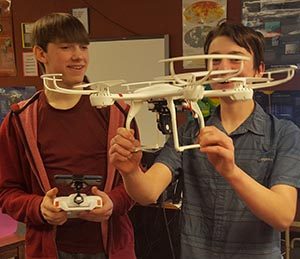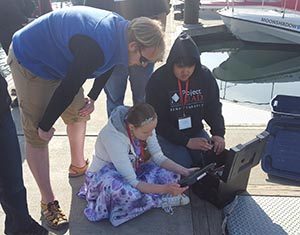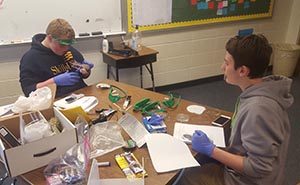By Beth Trowbridge
Executive Director for the Center for Alaskan Coastal Studies

Four Homer high school students, a project leader, and lots of volunteers took part in the center’s “Creating Teen Leaders through Marine Technology and Research” program this summer, helping monitor for aquatic invasive species throughout Kachemak Bay.
The students built an underwater remotely operated vehicle, or ROV, from a kit, which they used to explore the Homer and Seldovia harbors for aquatic invasive species. “We all had various skills that we could contribute but it took all of our expertise to organize, create, and improvise the structure,” said Landon Bunting, one of the students, describing the teamwork that developed between the students during the project.
The students also used drones to help learn to navigate the underwater ROV. “Flying the drones and watching them be flown allowed for a better understanding of operating ROVs through a ‘fluid’ such as air or water,” added Bunting. “This experiment allowed each of us to learn from our mistakes and to learn the benefit of different types of remote operated vehicles.”
The students identified many native species through their project, helping gather baseline biological data as well. “With all of us growing up near or around coastal Alaska, we all had a general idea of the aquatic invertebrates inhabiting the dock, and were able to identify several anemone, limpet, barnacle and mussel species,” said Jay Davis, another student. “It is good to see that the Homer harbor is free of invasive invertebrates, at least based on what we were able spot and identify.”

“It was surprising to see the differences between old and new docks and how the species differed between the mouth of the harbor and the far side,” said Cody Bond, another student. “The controls were weird but we could still see all the sea life clinging onto the docks and make good observations on the sites we monitored.”
The students also made a trip across Kachemak Bay to observe underwater species around Seldovia. “It was interesting to see that a newer area of the dock didn’t have sponges or shield limpets like the rest did, but did have a small crab,” added Bond. “It was also surprising that areas away from the mouth were a lot more diverse than the ones closer to the mouth, but that could be because it’s closer to the area where people clean and gut fish.”
The data collected will help track how the diversity changes with each season. Fortunately, no invasive species were recorded.
The team learned not only about building and operating technology, but also the diversity of their natural world. Working with the drones and ROVs help Bunting realize potential career choices he never knew existed.
“I never knew I wanted to go into marine biology, so now I am definitely considering it,” said Bunting. “I’ve always loved engineering but now I kind of want to incorporate the two of them together.”
